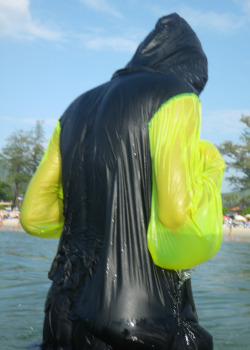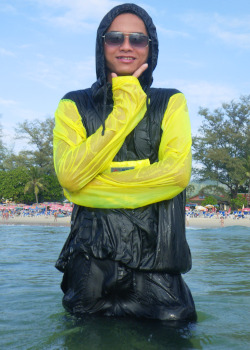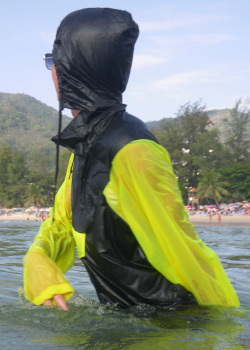Sun Protection Hoods
Hooded swim clothes can provide better sun protection for several reasons:
- Style
Hooded swim clothes can be ideal for fashion-forward beachgoers who prefer more interesting swimwear. They often have additional features like built-in pockets, which can be convenient for water activities that require more coverage. Wearing a hooded swimsuit can provide an extra layer of comfort and security for those who are concerned about their skin's vulnerability to the sun. - Increased coverage
Hooded swimsuits cover the head, neck, and ears, which are often exposed areas that receive direct sunlight. This increased coverage helps to prevent UV radiation from penetrating these sensitive areas, and can significantly reduce the risk of skin damage, premature aging, and even skin cancer. - Reduced exposure
The hood acts as a physical barrier between your skin and the sun's rays, reducing the amount of UV light that reaches your skin. This is especially important for fair-skinned individuals or those with a history of skin cancer. - Improved UPF protection
Many hooded swim clothes are designed to provide excellent Ultraviolet Protection Factor (UPF) ratings. A UPF rating measures how well clothing blocks UVA and UVB rays. Look for swim clothes with a high UPF rating, such as 50+, which indicates that the fabric will allow only 1/50th of the sun's UV radiation to pass through.
However, there are some potential drawbacks to consider:
- Unfamilarity
Wearing the hood while swimming may take some getting used to at first. - Heat build-up
The hood can trap heat and moisture, making you feel hotter than usual. This might be uncomfortable for those who prefer cooler temperatures while swimming or lounging. You can avoid this by keeping it wet. - Limited visibility
Depending on the design of the hood, it may obstruct your peripheral vision when looking up or down. This could be a concern if you're planning to engage in water activities that require good visual awareness, such as snorkeling or or fast splash sports. Make sure it fits well and is not too large.
When choosing a hooded swimwear, consider the following:
- Look for UPF-rated fabrics with high protection levels (30+).
- Opt for breathable, quick-drying materials to minimize heat buildup.
- Select styles with adjustable hoods or removable caps for better visibility and flexibility.
- Consider the activity you'll be doing while wearing these swim clothes. If it's not suitable for snorkeling or surfing, a hooded swimsuit might not be the best choice.
In summary, wearing hooded swim clothes can provide excellent sun protection by increasing coverage,
reducing exposure to UV radiation, and offering improved UPF ratings.
While there are some potential drawbacks to consider,
the benefits of enhanced sun protection, increased confidence,
and practicality make hooded swim clothes a great option
for those who care about skin health while enjoying water activities.



Reader Story: Sun Sensitive Skin
by Rafael, Saintes Maries de la Mer, Provence, FranceMy skin is very sun sensitive, I get sunburned quickly in the warm sunny country were I live by the sea. Swimming and watersports are my passion but I have to cover up all the time, even in the water. Swimming fully clothed isn't always easy.
Wetsuits are too warm except in winter. It is such a performance to put wetsuits on and off. They also take a long time to dry and are not breathable enough to be worn all day. Spandex swimsuits and rash guards are great for swimming, but a bit delicate for rough and tumble sports. I'm also not to keen on wearing them all day long.
Casual clothes are my usual swimwear, like joggers, jeans, tees, and hoodies. They feel great in the water, but take their time to dry.
So, I went to the local sports centre for advice. They said quick drying sportswear and leisure clothes would be best, like robust kite pants, sports shirts, anoraks and hoodies. Pants can be worn without underwear to dry faster. One doesn't want to sit in wet undies for long.
They suggested I should try on a few of these clothes in their large pool.
Great idea, right up my street.
I tried on a wide variety of clothes.
Wow, sportswear and rain clothes feel really good in the water and don't slow me down much.
In the morning I get dressed in these clothes and enjoy a swim in our pool.
On the way to university they dry off completely.
If I have time at university, I swim in their pool
and then dry off before the next lesson.
Many of my student friends have opted for similar clothes,
so they can swim without the need to get changed.
After university we go to the beach and swim fully clothed. Finally I take a long bath to rinse sweat and salt out of my clothes. Amphibious outfits are the best.
Last spring I went back to the sports centre to get more kit. When they heard how well it all worked out for me, they asked me to work in their shop and advise people with sensitive skin.
I work in and around the pool dressed in sportswear or rain clothes. Every time customers want to try kit in the water, I have to go into the pool with them and show them how to swim fully clothed. There is no time to change into swimwear, so I go into the water in all my clothes. Afterwards I change into a full set of dry clothes, ready for the next swim.
On holiday I go to Thailand where swimming fully clothed is the norm,
due to the intense sunshine.
My friends there always make sure I wear enough clothes to stay safe when we go swimming.
We all wear jeans and cotton hoodies in the water, which I enjoy a lot, feels so sensual.